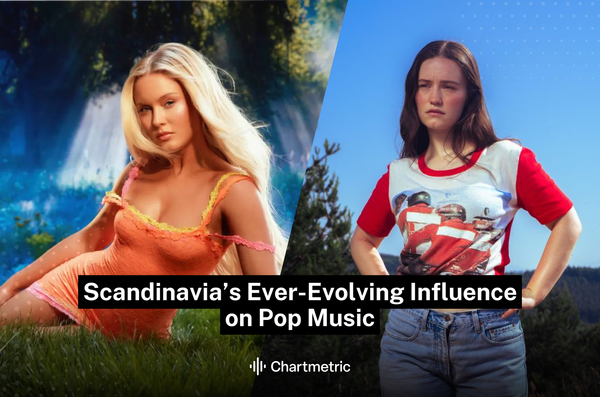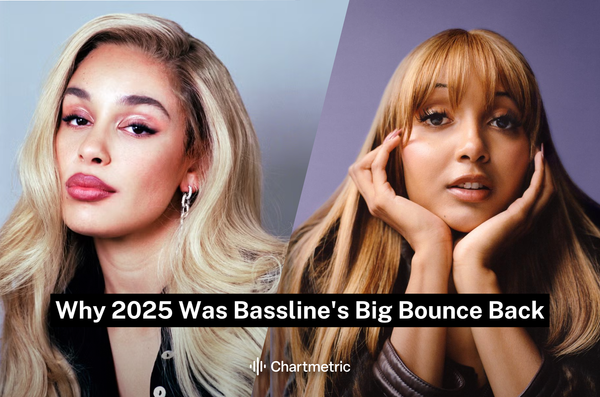When most people think of Scandinavian music, a certain Swedish disco-pop group comes to mind. But Scandinavia’s impact on global music didn’t start or end with ABBA (CM rank: 195).
Behind the scenes power producers like Max Martin, superstar DJs including Avicii (CM rank: 134), and pop groups like Ace of Base (CM rank: 1,172) have positioned Sweden as a global leader in pop music. And while Sweden’s pop contributions are especially prolific, artists from other countries including Sigrid, MØ, and AURORA are also expanding and redefining the “Scandipop” genre.
What makes Scandinavian music so dominant
Stein Bjelland is the Chair of Music Norway, the country’s music export facilitator. He says the region’s history of trading, wealth, and early adoption of the internet positioned it to be influential in global music. Scandinavian consumers were among the first to stream music.
“For quite a while you would see a lot of Nordic pop music on the streaming charts,” Bjelland said. “We were early adopters so we were pushing a lot of music into the system. That window brought Scandinavian music to the world.”
The culture around traveling also means most young people are fluent in English, supporting a generation of people who can write music targeted towards a global audience. Music lessons are also mandatory throughout school, an offering that Max Martin has credited with his career.
National export offices, like the one Bjelland chairs, aim to elevate music from each country to the global stage. These organizations help fund artist development, support tours, and promote local artists at trade fairs.
The Swedish artist Tove Lo (CM rank: 641) described Scandipop as music "you can dance, cry and drink to.” Tove Lo rose to fame with "Habits (Stay High)," an anthem celebrating hedonism as an escape from heartbreak. She follows a long tradition of Scandinavian artists who blend upbeat sounds with emotional or sad lyrics, from Robyn’s "Dancing on My Own" to "Lovefool" by the Cardigans.
EDM’s prominence on the charts during the 2010s benefitted the region which, along with broader Europe, already had a history of producing and consuming that kind of music. Still, Scandinavian music has never exclusively embraced a single sound.
The most common genres for the top 500 artists across the region are pop, house, and metal. Looking at the top artists for each individual country shows pop’s dominance in Sweden, with over 87% of leading artists tagged with that genre.
Sweden
Over half of the top 500 Scandinavian artists based on Chartmetric Score are Swedish. The country is also home to streaming services like Spotify and has birthed charting artists in every decade since the 1970s.
Sweden shares many cultural factors with Denmark and Norway that have supported its musical dominance, but Bjelland notes that when ABBA became a global success, they toured with a Swedish team. “When they came back to Sweden they brought all the knowledge back to Sweden.”
Sweden’s history of pop dominance means older acts continue to enjoy streaming success, but other Swedish artists are also experiencing new growth. Zara Larsson (CM rank: 371), who is preparing to release her album Midnight Sun while touring with Tate McRae, has surged this summer—rising from just under 23M to over 26M monthly listeners.
Even people who aren’t familiar with Larsson will probably recognize “Never Forget You,” an EDM-tinged tracker which peaked at #13 on the Hot 100 in 2016. Her sound has shifted alongside evolving pop sensibilities but has maintained a dancey and energetic sound.
@chartmetric Do you think Zara Larsson is gonna come back in full effect with her upcoming album? #zaralarsson #tatemcrae #midnightsun #sportscar #revolvingdoor #misspossessivetour #musicnews @Zara Larsson @tate mcrae
♬ original sound - Chartmetric
Norway
Norway first enjoyed global success with "Take on Me" by A-ha. But unlike ABBA, the band was based in the UK, so their hit-making experience didn’t make it back to the Norwegian music industry. While the country had a strong Black Metal scene in the early 80s and 90s, global pop music was a slower sell. “We didn't really believe in commercial pop music until 20 years ago,” Bjelland said.
That shift was helped by a uniquely Norwegian tradition: Russefeiring, a celebration for high school graduates where groups of students buy a bus and often commission a song to blast during the month-long party. These so-called Russ songs - loud, electronic, and often over the top - create a built-in market for high-energy dance music long before it gains mainstream approval.
“In the beginning the industry didn't want to touch this kind of music because the lyrics are way over the top. It's kind of cheesy, electronic, EDM,” Bjelland said. “...Now, a lot of these songs are in the top 10 [in Norway]”.
Russ music can also be a stepping stone for artists and DJs. Kygo and Alan Walker both created songs in this genre early in their careers. Today, both artists have user-generated playlist support superseding the 150M marks on Spotify.
Norwegian pop artists like Aurora and Sigrid also play with electronic and electro-pop sounds in their music.
Sigrid, who explores empowerment, heartbreak, and frustration with catchy choruses, won BBC’s Sound of Music poll in 2018 and has experienced steady popularity since then. In an interview at the time she said “I think the Scandi ‘thing’ is very intricate melodies. English is our second language, and that creates a barrier where you have to concentrate on the melody. Because of that, I guess there's a history of making good vocal hooks - and that makes good pop music.”
Denmark
Alternative music is a growing force in the Danish music scene. Alt-pop and indie sounds have been bolstered by Copenhagen’s Rhythmic Music Conservatory (RMC). The school, which specialized in jazz until 2009, is ushering in a new generation of Danish artists.
Dazed has characterized this developing genre as “underground dream pop”, with artists like Erika de Casier, Astrid Sonne, and Clarissa Connelly, all RMC alumni. Fine, another Danish artist in this category has described her sound as “driving at night in the desert in a David Lynch movie, peacefully flying in the dark.”
This group of alternative-pop artists have also attracted the attention of Spotify editors, with curated playlists expanding their reach.
Spotify’s playlist Cph+ embraces the alt-pop sounds of RMC and the broader music scene even beyond Copenhagen. The playlist, which features many artists from the U.S. and U.K., highlights the smaller-scale ways Danish sounds are going global.
What’s next for the region
With each country’s export office continuing to support and elevate artists to the international stage, Scandinavia’s influence on the music scene will likely continue to grow.
Bjelland has also noticed that more artists across the region are embracing performing in their own languages. Although he doesn’t see non-English language music always translating to global success, hyperlocalization can be a feasible strategy for gaining domestic audiences in a streaming-first world.
Tobias Rahim (Denmark) and Thomas Stenström (Sweden) have each surpassed 1 million monthly listeners, largely with audiences from their home countries. The international success of K-Pop and Spanish-language songs has shown an appetite for multilingual music though, and time will tell if non-English language Scandi music will also go global.





